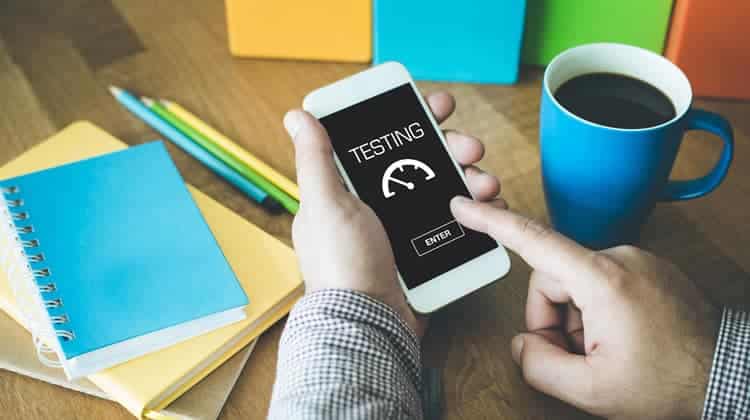As the number of gadgets continues to flood the market, mobile app testing has also become a vital phase of the app development process. Developers desire the best user experience, but achieving it is not a walk in the park since testing needs more than emulators and simulators. The uniqueness of real device testing is that the developer uses a device they hold in their hand and a wide variety of devices from various handset manufacturers. This paper looks into the advantages and increased need for the testing of apps on real devices across the platform for delivering a seamless user experience.
Testing mobile apps on real devices provides insights that simulators cannot duplicate. Real device testing tackles the subtleties that would go unnoticed, from real hardware performance measurements to practical application usability. Since applications have cross-platform effects, developers should focus not only on functionality but also on compatibility and response interchangeably across different situations subject to user-human-computer interaction using a wide range of devices with varying specifications.
What are Cross-Platform Apps, and Why Are They Important?
Cross-platform applications refer to those software programs developed to be used on several platforms and different operating systems. The cross-platform apps are developed using the frameworks and tools that allow developers to write code one time and deploy it across multiple platforms, such as iOS, Android, and sometimes web platforms, unlike traditional applications that are designed solely for one operating system.
There are many reasons why cross-platform applications are quite relevant in software development, especially considering the increased need for mobility in modern business.
- Cost and Time Efficiency: Cross-platform applications reduce development time and cost by nearly half because the same code can be used to develop several systems.
- Expanded Reach: Creating for various platforms, such as iOS, Android, or even the web, helps the developers present their development to a wider audience, bringing more potential users to their product.
- Consistency: Using just one codebase, which makes the features, functionality and the entire user experience of a service consistent across all platforms, helps ensure customer satisfaction and brand recognition.
- Ease of Maintenance: Due to the common code base employed, developers can implement updates or fix the bugs much faster to ensure the same program version is available for customers across all platforms.
- Streamlined Development Processes: With the ability to work with familiar tools and frameworks, cross-platform development provides a more consistent developer experience, leading to better workflows, productivity, and collaboration.
- Adaptability to Changing Technologies: Frameworks for cross-platform development always change, giving programmers new capabilities and tools to meet users’ needs and evolving technology.
Challenges in Cross-Platform App Development
While cross-platform application development has numerous benefits, it also presents a unique set of difficulties. The fragmentation of devices, operating systems, and screen sizes is a significant concern.
Device Fragmentation:
The hardware specs, screen sizes, resolutions, and performance capabilities of various devices differ. Because of this variability, it can be difficult for developers to ensure that their apps work as well as possible across various devices without degrading user experience.
Operating System Differences:
Every operating system, including Android, iOS, and others, has a unique collection of APIs, programming languages, and design standards. While keeping the functionality and user interface of the program consistent across platforms, developers must negotiate these variations.
Screen Sizes and Resolutions:
The development of smartphones, tablets, and other mobile gadgets also asks makers of apps to ensure that their apps have adaptive and scalable properties, allowing apps to work on screens with different sizes and resolutions. This calls for appropriate design and planning techniques that enable the production of efficient interfaces and layouts that perform well on different devices.
Native Functionality Integration:
Although many native device capabilities and APIs are accessible through cross-platform frameworks, there could still be restrictions or functional differences compared to native programming. It might be difficult for developers to integrate intricate native functionality and guarantee consistent platform behavior.
Performance Optimization:
With runtime environments and abstraction layers, such development has a price, which can lead to performance issues if we introduce cross-platform applications. To cut on resource utilization, improve app performance, and provide a user-friendly utility to the end-users, optimization methods have to be used by developers.
Debugging and Testing:
It might take a lot of effort and complexity to test cross-platform programs across many platforms, devices, and configurations. For their apps to function consistently in various settings, developers must invest in thorough testing methods, such as automated frameworks.
Benefits of Real Device Testing for Cross-Platform Apps
Cross-platform apps that have undergone real device testing have several advantages that improve the apps’ overall usability and quality. Among the principal benefits are:
User Experience Accuracy
Developers may evaluate their cross-platform apps’ performance on many devices with variable hardware configurations, screen sizes, resolutions, and operating system versions with accuracy thanks to real device testing. This guarantees the application a uniform and ideal user experience on all intended devices.
Detection of Hardware-Specific Issues
Hardware-specific problems, such as compatibility problems, performance bottlenecks, and device-specific flaws that might not be seen in emulator-based testing environments, can be found by testing on real devices. Because of this, developers can ensure seamless functioning across a wide range of platforms and address these concerns early in the development process.
Validation of Device-Specific Features
Real device tests could be used to test developers on the operations of their device-specific functions, including GPS, camera, accelerometer, gyroscope, and fingerprint sensor. This is what real-world testing is all about – by implementing features in a real-life environment, developers can guarantee that these features will operate according to the design, no matter the type of platform or device. This positively influences the app’s usability and overall functionality.
Optimization of Performance and Battery Life
The process of testing cross-platform applications is very strict, and the apps are made to give the user a stable and uniform quality on different devices, platforms, etc. This gives satisfaction to the users and makes them stay with the app, which leads to positive reviews and information, thus making it popular and a market leader.
Improved User Satisfaction and Retention
Cross-platform applications, which are thoroughly tested on real devices, allow developers to provide a deterministic, steady, and superior user experience in the broadest scope of platforms and devices possible. This leads to higher satisfaction from the user, keeps users on the app longer, and promotes positive reviews and recommendations, all of which help the app grow, become more popular, and strengthen its position on the market.
Moreover, for developers seeking efficient and comprehensive real-device testing solutions, platforms like LambdaTest offer invaluable resources. LambdaTest is an AI-powered test orchestration and execution platform that lets you run manual and automated tests at scale with over 3000+ real devices, browsers, and OS combinations.
With this platform, developers and testers can test their cross-platform apps on a wide range of real devices and browsers, thanks to its cloud-based architecture. Developers can easily expand their testing efforts with LambdaTest, guaranteeing performance and compatibility across various device configurations.
The platform is useful for expediting the testing process and enhancing app quality because of its user-friendly interface and wide device coverage. Developers may improve user experience across many platforms and devices, boost performance, and resolve compatibility concerns by utilizing LambdaTest.
How Real Device Testing Boosts App Quality?
Real device testing provides a more thorough and accurate evaluation of the application’s functionality, performance, and user experience across multiple devices, which greatly improves the quality of apps. The following are some ways that real device testing improves the quality of apps:
Device Diversity
Thanks to real device testing, developers can test their apps on various devices with varying screen sizes, resolutions, hardware setups, and operating system versions. This diversity aids in finding differences in performance, consistency in layout, and compatibility that may not be apparent in emulator-based testing settings.
Real-World Conditions
Developers can mimic real-world usage situations and environmental factors, like changing network speeds, signal levels, and device orientations, by testing on real devices. This assists in identifying network connectivity, responsiveness, and usability problems that may affect the user experience as a whole.
Hardware-Specific Testing
Real device testing makes detecting hardware-specific issues such as battery depletion, performance optimization, and sensor compatibility (GPS, camera, accelerometer) more convenient. Testing on real devices will allow developers to ensure that the app uses device capabilities in the most efficient way possible and shows uniformity in user experience regardless of the device hardware configuration.
User Experience Optimization
Real device testing is another method that allows developers to measure the user interface, the navigation flow, and the interaction patterns in general of their apps on real mobile devices, providing valuable information on UX design concerns. It includes evaluating the parts such as visuals, screen transitions, gesture support, and touch responsiveness to ensure the same fluid and usable user experience across all platforms. To guarantee a smooth and simple user experience across various devices and form factors, this involves assessing touch responsiveness, gesture support, screen transitions, and visual aspects.
Performance Benchmarking
With real device testing, developers may set benchmarks for various metrics, such as CPU utilization, memory consumption, and loading and response times, under real-world situations. Consequently, they can find resource-heavy processes, memory leaks, and performance-constrained situations that can affect the app’s performance on particular devices or under specific use conditions.
Security and Privacy Assessment
Developers can assess an application’s privacy protections, data encryption, secure authentication, permissions management, and regulatory compliance on real devices by using real device testing. By doing this, possible security flaws and privacy concerns are found and reduced before the program is made available to end users.
Iterative Improvement and Feedback
By allowing developers to find problems, get user input, and iterate on app features and functions based on real-world usage data, real device testing promotes quick feedback loops and iterative improvement. This iterative process promotes ongoing quality improvement and customer happiness by improving the app’s functionality, performance, and design over time.
Conclusion
To sum up, real device testing is essential to guaranteeing cross-platform applications work well and provide a positive user experience on various hardware and operating systems. Developers may produce apps that match industry standards and user expectations by using real device testing, which addresses hardware-specific concerns, fragmentation of devices, and real-world settings.
For developers looking for effective and all-inclusive real device testing solutions, LambdaTest and similar platforms provide invaluable tools. LambdaTest accelerates app delivery, ensures compatibility across various device configurations, and streamlines the testing process using cloud-based architecture and broad device coverage.
In a cutthroat app market where user experience is paramount, real device testing becomes essential to app quality control. Developers may iterate, enhance, and create innovative cross-platform apps that connect with users and propel success in the digital environment by using real device testing procedures.







